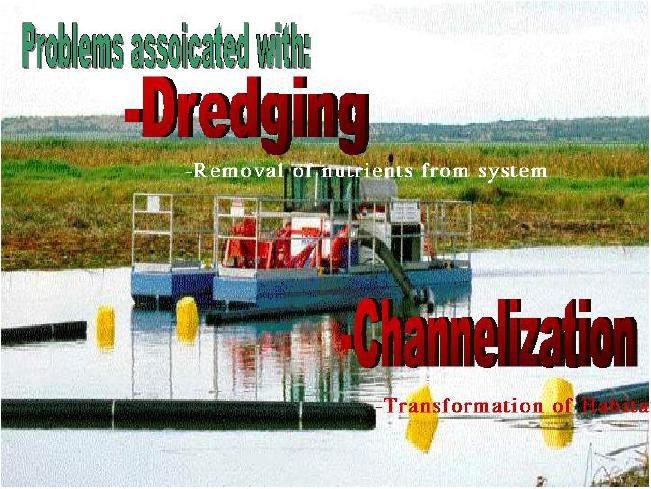
|
|
Dredging and chanelization are also ways in which man does great harm to salt marshes.
Dredging removes sediments which are nutrient rich and dumps them out at sea, where
they will never be recovered or useful to costal marshes. In effect, dredging removes
the nourishment that costal ecosystems like salt marshes depend on for sustenance. In
most cases, the dredged sediment is dumped well below the wave base, making its return
to costal ecosystems impossible. For example, in the case of Savannah, Georgia, over 7
million cubic yards of sediment are dredged annually. This is 7 million cubic yards of
nutrient rich sediment that will leave the natural system forever. The islands that are
most affected are ones down current from the dredging site, because, as was outlined
previously, due to the ebb tide delta system, the nutrient rich sediment would normally
flow down current and supply those particular islands, instead, after dredging, they are
starved. Channelization is another way in which man threatens the salt marsh habitat. In Louisiana, 10% of marshland is covered by channels and cannels, most of which are created to provide either navigation to gas and oil drill sites, or to lay pipelines for the same purpose. The canals are far more numerous and deeper than the channels, and hence, have a greater effect on the marshland. The major problem with channelization and canals, as determined by L. P. Rozas, lies in the fact that sediment that is dredged for canals is piled up alongside the canal, which in effect changes the habitat of the marsh to an "upland" habitat; it brings the land mass far above the water level, making the area uninhabitable for native species, except during periods of unusually high tides. When an area of a marsh becomes enclosed by excessive channelization, it can become separated from the rest of the marsh and be rendered uninhabitable. The piles of dredged sediment promote ponding of parts of marshes, as well as stagnation and little to no exchange of water between areas of a marsh. This can act as a positive feedback system, contributing to the conversion of more marshland to open water. In addition, the unnatural banks and shapes of man made channels can inhibit natural processes that would occur in an untouched marsh. Rozas does not advocate stopping canal construction all together in order to combat these problems, but instead, he studied a practical solution. He found that if the piles of sediment that form the banks of a canal or channel are breached at regular intervals to allow water to flow between the canal or channel and the rest of the marsh, the negative effects could be minimized. These breaches not only prevent ponding in most instances, but they also allow small organisms, which are vital to primary production, to move between the areas of marsh and sustain the habitats. (Graphic: http://www.dredgepro.com )
| |
|